








At a very early stage of culture most peoples manifest decided artistic tendencies, which are revealed in attempts to depict various devices, life forms, and fancies upon the skin and upon the surfaces of utensils, garments, and other articles and objects. The figures are very often decorative in effect and may be of a trivial nature, but very generally such art is serious and pertains to events or superstitions. The devices employed may be purely conventional or geometric, containing no graphic element whatever; but life forms afford the most natural and satisfactory means of recording, conveying, and symbolizing ideas, and hence preponderate largely. Such forms, on account of their intimate relations with the philosophy of the people, are freely embodied in every art suitable to their employment. As already seen, the peculiar character of textile construction places great difficulties in the way of introducing unsymmetric and complex figures like those of natural objects into fabrics. The idea of so employing them may originally have been suggested by the application of designs in color to the woven surfaces or by resemblances between the simpler conventional life form derivatives and the geometric figures indigenous to the art.
At any rate, the idea of introducing life forms into the texture was suggested, and in the course of time a great deal of skill was shown in their delineation, the bolder workmen venturing to employ a wide range of graphic subjects.
Now, if we examine these woven forms with reference to the modifications brought about by the textile surveillance, we find that the figures, as introduced in the cloth, do not at all correspond with those executed by ordinary graphic methods, either in degree of elaboration or in truthfulness of expression. They have a style of their own. Each delineative element upon entering the textile realm is forced into those peculiar conventional outlines imposed by the geometric construction, the character of which has already been dwelt upon at considerable length. We find, however, that the degree of convention is not uniform throughout all fabrics, but that it varies with the refinement of the threads or filaments, the compactness of the mesh, the character of the combination, the graphic skill of the artist, and the tendencies of his mind; yet we observe that through all there is still exhibited a distinct and peculiar geometricity.
So pronounced is this technical bias that delineations of a particular creature—as, for example, a bird—executed by distant and unrelated peoples, are reduced in corresponding styles of fabric to almost identical shapes. This conventionalizing force is further illustrated by the tendency in textile representation to blot out differences of time and culture, so that when a civilized artisan, capable of realistic pictorial delineation of a high order, introduces a figure into a certain form of coarse fabric he arrives at a result almost identical with that reached by the savage using the same, who has no graphic language beyond the rudest outline.
A number of examples may be given illustrating this remarkable power of textile combination over ornament. I select three in which the human figure is presented. One is chosen from Iroquoian art, one from Digger Indian art, and one from the art of the Incas—peoples unequal in grade of culture, isolated geographically, and racially distinct. I have selected specimens in which the parts employed give features of corresponding size, so that comparisons are easily instituted. The example shown in Fig. 338 illustrates a construction peculiar to the wampum belts of the Iroquois and their neighbors, and quite unlike ordinary weaving. It is taken from the middle portion of what is known as the Penn wampum belt. The horizontal series of strands consists of narrow strips of buckskin, through which the opposing series of threads are sewed, holding in place the rows of cylindrical shell beads. Purple beads are employed to develop the figures in a ground of white beads. If the maker of this belt had been required to execute in chalk a drawing depicting brotherly love the results would have been very different.
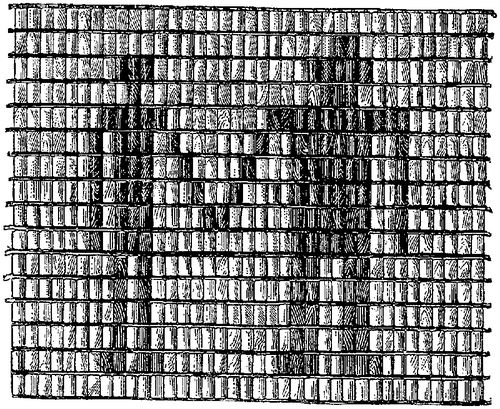
Fig. 338. Figures from the Penn wampum belt, showing the conventional form imposed in bead work.ToList
My second illustration (Fig. 339) is drawn from a superb example of the basketry of the Yokut Indians of California. The two figures form part of a spirally radiating band of ornament, which is shown to good advantage in the small cut. Fig. 340. It is of the coiled style of construction. The design is worked in four colors and the effect is quiet and rich.
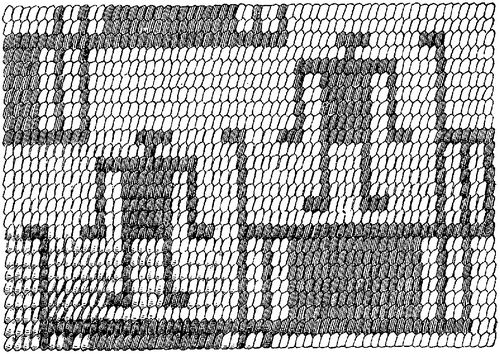
Fig. 339. Conventional figures from a California Indian basket.ToList
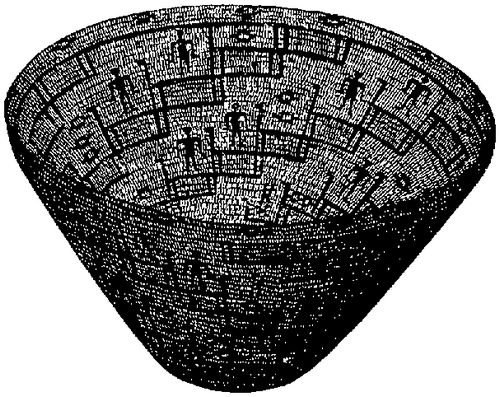
Fig. 340. Basket made by the Yokut Indians of California.ToList
Turning southward from California and passing through many strange lands we find ourselves in Peru, and among a class of remains that bespeak a high grade of culture. The inhabitants of Ancon were wonderfully skilled in the textile art, and thousands of handsome examples have been obtained from their ancient tombs. Among these relics are many neat little workbaskets woven from rushes. One of these, now in the National Museum, is encircled by a decorated belt in which are represented seven human figures woven in black filaments upon a brown ground.
The base and rim of the basket are woven in the intertwined combination, but in the decorated belt the style is changed to the plain right angled interlacing, for the reason, no doubt, that this combination was better suited to the development of the intended design. Besides the fundamental series of fillets the weaver resorted to unusual devices in order to secure certain desired results. In the first place the black horizontal series of filaments does not alternate in the simplest way with the brown series, but, where a wide space of the dark color is called for, several of the brown strands are passed over at one step, as in the head and body, and in the wider interspaces the dark strands pass under two or more of the opposing strands. In this way broad areas of color are obtained. It will be observed, however, that the construction is weakened by this modification, and that to remedy the defect two additional extra constructive series of fillets are added. These are of much lighter weight than the main series, that they may not obscure the pattern. Over the dark series they run vertically and over the light obliquely.
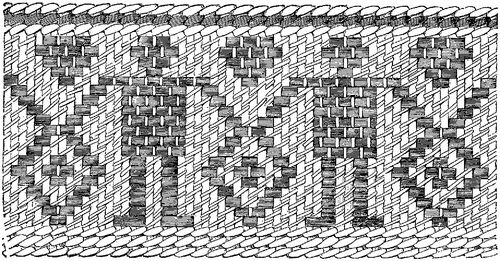
Fig. 341. Conventional human figures from an ancient Peruvian basket.ToList
It will be seen that the result, notwithstanding all this modification of procedure, is still remarkably like that of the preceding examples, the figures corresponding closely in kind and degree of geometricity.
The fact is that in this coarse work refinement of drawing is absolutely unattainable. It appears that the sharply pronounced steps exhibited in the outlines are due to the great width of the fillets used. With the finer threads employed by most nations of moderate culture the stepped effect need not obtrude itself, for smooth outlines and graceful curves are easily attainable; yet, as a rule, even the finer fabrics continue to exhibit in their decorations the pronounced geometric character seen in ruder forms. I present a striking example of this in Fig. 342, a superb piece of Incarian gobelins, in which a gaily costumed personage is worked upon a dark red ground dotted with symbols and strange devices. The work is executed in brilliant colors and in great detail. But with all the facility afforded for the expression of minutely modulated form the straight lines and sharp angles are still present. The traditions of the art were favorable to great geometricity, and the tendencies of the warp and woof and the shape of the spaces to be filled were decidedly in that direction.

Fig. 342. Human figure in Peruvian gobelins, showing characteristic textile convention. From chromolithographs published by Reiss and Stübel in The Necropolis of Ancon.ToList
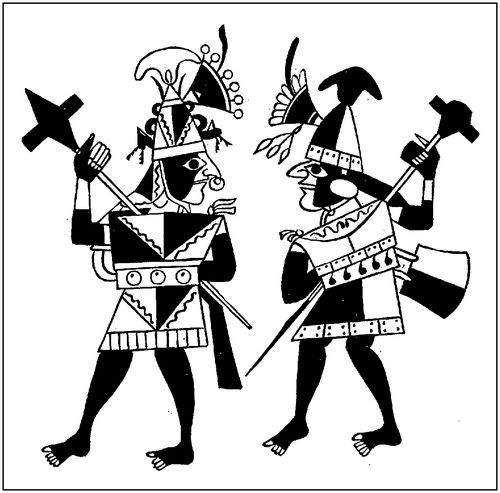
Fig. 343. Human figures from a Peruvian vase, done in free hand, graphic style.ToList
In order that the full force of my remarks may be appreciable to the eye of the reader, I give an additional illustration (Fig. 343). The two figures here shown, although I am not able to say positively that the work is pre-Columbian, were executed by a native artist of about the same stage of culture as was the work of the textile design. These figures are executed in color upon the smooth surface of an earthen vase and illustrate perfectly the peculiar characters of free hand, graphic delineation. Place this and the last figure side by side and we see how vastly different is the work of two artists of equal capacity when executed in the two methods. This figure should also be compared with the embroidered figures shown in Fig. 348.
The tendencies to uniformity in textile ornament here illustrated may be observed the world over. Every element entering the art must undergo a similar metamorphosis; hence the remarkable power of this almost universally practiced art upon the whole body of decorative design.
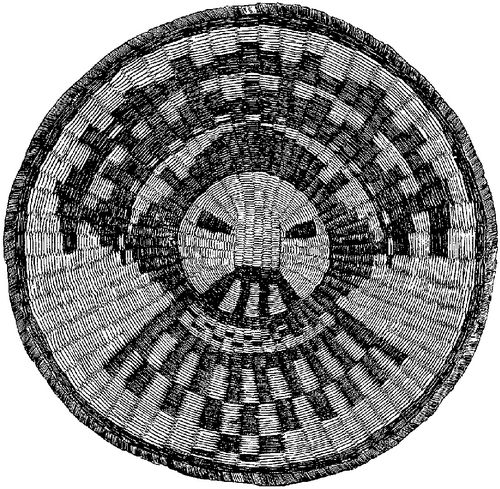
Fig. 344. Human figure modified by execution in concentric interlaced style of weaving—1/3.ToList
That the range of results produced by varying styles of weaving and of woven objects may be appreciated, I present some additional examples. Coiled wares, for instance, present decorative phenomena strikingly at variance with those in which there is a rectangular disposition of parts. Instead of the two or more interlacing series of parallel fillets exhibited in the latter style, we have one radiate and one concentric series. The effect of this arrangement upon the introduced human figure is very striking, as will be seen by reference to Fig. 344, which represents a large tray obtained from the Moki Indians. The figure probably represents one of the mythologic personages of the Moki pantheon or some otherwise important priestly functionary, wearing the characteristic headdress of the ceremony in which the plaque was to be used. The work is executed in wicker, stained in such bright tints as were considered appropriate to the various features of the costume. Referring in detail to the shape and arrangement of the parts of the figure, it is apparent that many of the remarkable features are due to constructive peculiarities. The round face, for example, does not refer to the sun or the moon, but results from the concentric weaving. The oblique eyes have no reference to a Mongolian origin, as they only follow the direction of the ray upon which they are woven, and the headdress does not refer to the rainbow or the aurora because it is arched, but is arched because the construction forced it into this shape. The proportion of the figure is not so very bad because the Moki artist did not know better, but because the surface of the tray did not afford room to project the body and limbs.

Fig. 345. Figure of a bird painted upon a Zuñi shield, free hand delineation.ToList
Now, it may be further observed that had the figure been placed at one side of the center, extending only from the border to the middle of the tray, an entirely different result would have been reached; but this is better illustrated in a series of bird delineations presented in the following figures. With many tribes the bird is an object of superstitious interest and is introduced freely into all art products suitable for its delineation. It is drawn upon walls, skins, pottery, and various utensils and weapons, especially those directly connected with ceremonies in which the mythical bird is an important factor. The bird form was probably in familiar use long before it was employed in the decoration of basketry. In Fig. 345 I present an ordinary graphic representation. It is copied from a Zuñi shield and is the device of an order or the totem of a clan. The style is quite conventional, as a result of the various constraints surrounding its production. But what a strange metamorphosis takes place when it is presented in the basketmaker's language. Observe the conventional pattern shown upon the surface of a Moki tray (Fig. 346). We have difficulty in recognizing the bird at all, although the conception is identical with the preceding. The positions of the head and legs and the expanded wings and tail correspond as closely as possible, but delineation is hampered by technique. The peculiar construction barely permits the presentation of a recognizable life form, and permits it in a particular way, which will be understood by a comparison with the treatment of the human figure in Fig. 344. In that case the interlaced combination gives relievo results, characterized by wide, radiating ribs and narrow, inconspicuous, concentric lines, which cross the ribs in long steps. The power of expression lies almost wholly with the concentric series, and detail must in a great measure follow the concentric lines. In the present case (Fig. 346) this is reversed and lines employed in expressing forms are radiate.
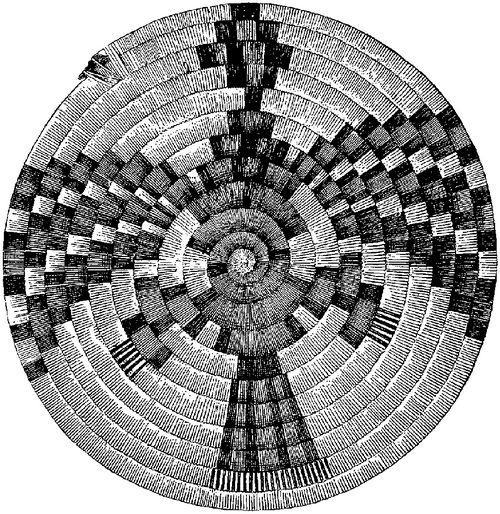
Fig. 346. Figure of a bird executed in a coiled Moki tray, textile delineation.ToList
The precise effect of this difference of construction upon a particular feature may be shown by the introduction of another illustration. In Fig. 347 we have a bird woven in a basket of the interlaced style. We see with what ease the long sharp bill and the slender tongue (shown by a red filament between the two dark mandibles) are expressed. In the other case the construction is such that the bill, if extended in the normal direction, is broad and square at the end, and the tongue, instead of lying between the mandibles, must run across the bill, totally at variance with the truth; in this case the tongue is so represented, the light vertical band seen in the cut being a yellow stripe. It will be seen that the two representations are very unlike each other, not because of differences in the conception and not wholly on account of the style of weaving, but rather because the artist chose to extend one across the whole surface of the utensil and to confine the other to one side of the center.
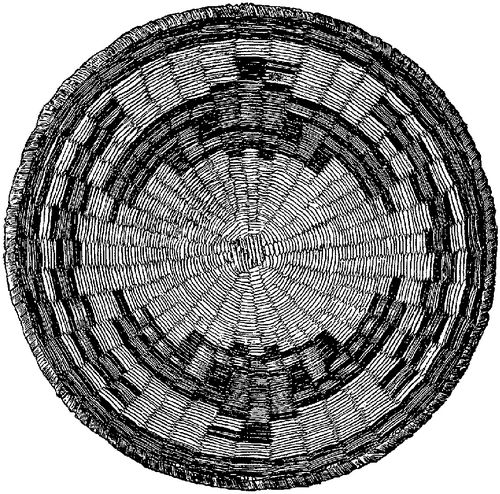
Fig. 347. Figure of a bird woven in interlaced wicker at one side of the center.ToList
It is clear, therefore, from the preceding observations that the convention of woven life forms varies with the kind of weaving, with the shape of the object, with the position upon the object, and with the shape of the space occupied, as well as with the inherited style of treatment and with the capacity of the artist concerned. These varied forces and influences unite in the metamorphosis of all the incoming elements of textile embellishment.
It will be of interest to examine somewhat closely the modifications produced in pictorial motives introduced through superstructural and adventitious agencies.
We are accustomed, at this age of the world, to see needlework employed successfully in the delineation of graphic forms and observe that even the Indian, under the tutelage of the European, reproduces in a more or less realistic way the forms of vegetal and animal life. As a result we find it difficult to realize the simplicity and conservatism of primitive art. The intention of the primitive artist was generally not to depict nature, but to express an idea or decorate a space, and there was no strong reason why the figures should not submit to the conventionalizing tendencies of the art.
I have already shown that embroidered designs, although not from necessity confined to geometric outlines, tend to take a purely geometric character from the fabric upon which they are executed, as well as from the mechanical processes of stitching. This is well shown in Fig. 348, a fine specimen given by Wiener in his work Pérou et Bolive.
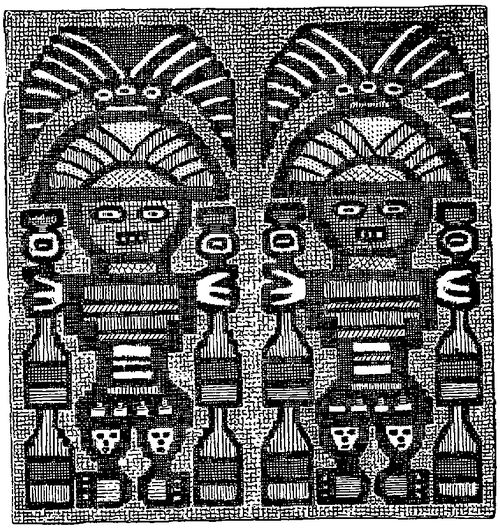
Fig. 348. Embroidery upon a cotton net in which the textile combinations are followed step by step. Ancient Peruvian work.ToList
A life form worked upon a net does not differ essentially from the same subject woven in with the web and woof. The reason is found in the fact that in embroidery the workman was accustomed from the first to follow the geometric combination of the foundation fabric step by step, and later in life delination he pursued the same method.
It would seem natural, however, that when the foundation fabric does not exhibit well marked geometric characters, as in compactly woven canvas, the needlework would assume free hand characters and follow the curves and irregularities of the natural object depicted; but such is not the case in purely aboriginal work. An example of embroidery obtained from an ancient grave at Ancon, Peru, is shown in Fig. 349. A piece of brown cotton canvas is embellished with a border of bird figures in bright colored wool thread. The lines of the figures do not obey the web and woof strictly, as the lines are difficult to follow, but the geometric character is as perfectly preserved as if the design were woven in the goods.
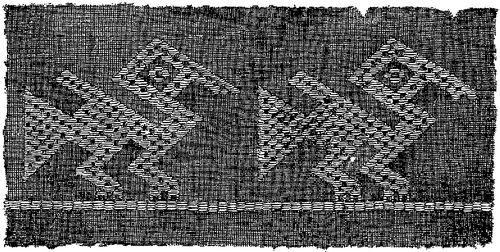
Fig. 349. Embroidery in which the foundation fabric is not followed accurately, but which exhibits the full textile geometricity. Ancient Peruvian work.ToList
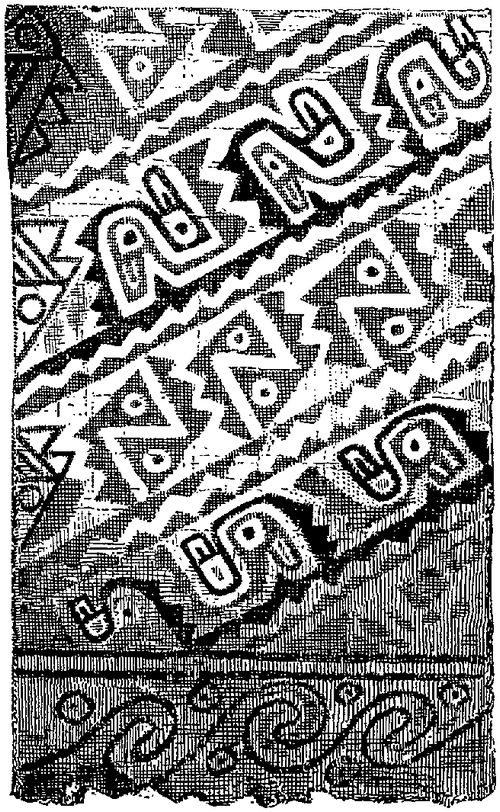
Fig. 350. Design painted in color upon a woven surface, exhibiting the full degree of geometric convention. Ancient Peruvian work. Copied from The Necropolis of Ancon.ToList
So habit and association carry the geometric system into adventitious decoration. When the ancient Peruvian executed a design in color upon a woven surface (Fig. 350), using a pencil or brush, the result was hardly less subject to textile restraint.
As a matter of course, since there are two distinct styles of decorative design—the textile and the free hand—there exist intermediate forms partaking of the character of both; but it is nevertheless clear that the textile system transforms or greatly modifies all nature motives associated with it, whether introduced into the fabric or applied to its surface.
In countries where the textile art is unimportant and the textile system of decoration does not obtrude itself, free hand methods may prevail to such an extent that the geometric influence is but little felt. The Haidah Indians, for example, paint designs with great freedom and skill, and those applied to woven surfaces are identical with those executed upon skins, wood, and stone, but this art is doubtless much modified by the means and methods of Europeans. Our studies should be confined wholly to pure indigenous art.